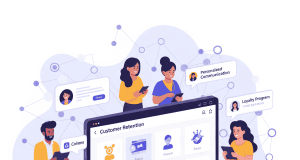In today’s competitive landscape, businesses recognize that customer experience (CX) is a critical differentiator. Brands that prioritize CX often see enhanced loyalty, higher retention rates, and increased revenue. However, delivering an exceptional customer experience requires the right tools. This guide explores various customer experience tools and how they can foster deeper relationships with customers, driving growth and success.
Understanding Customer Experience (CX)
Customer experience encompasses every interaction a customer has with a company, from first impressions to post-purchase support. Delivering a seamless and positive experience is essential. Elements influencing CX include:
- User Interface and Experience (UI/UX): The aesthetics and functionality of a company’s platforms.
- Customer Service: The efficiency and effectiveness of support services provided to customers.
- Feedback Mechanisms: Structures in place for customers to share their opinions and experiences.
A well-integrated approach to CX considers all touchpoints and leverages the right tools to optimize them.
Key Types of Customer Experience Tools
1. Customer Relationship Management (CRM) Systems
Popular Tools: Salesforce, HubSpot, Zoho CRM
CRM systems are vital for managing customer interactions and data throughout the customer lifecycle. They facilitate:
- Centralized customer information storage
- Tracking customer interactions and history
- Identifying sales opportunities and trends
Effective CRM systems empower businesses to build stronger relationships by personalizing communications and anticipating customer needs.
2. Feedback and Survey Tools
Popular Tools: SurveyMonkey, Qualtrics, Typeform
Feedback tools allow businesses to gather insights directly from customers about their experiences. This data can help:
- Measure customer satisfaction (CSAT) and Net Promoter Score (NPS)
- Identify areas for improvement
- Inform product development and service enhancements
Using structured feedback mechanisms enables businesses to listen actively to their customers and respond accordingly.
3. Customer Support and Help Desk Platforms
Popular Tools: Zendesk, Freshdesk, Intercom
These platforms streamline customer support, enabling companies to manage inquiries and issues efficiently. Features often include:
- Ticketing systems for tracking customer inquiries
- Multichannel support (email, chat, phone)
- Knowledge bases and self-service options
A robust support platform enhances the customer experience by ensuring prompt and effective resolution of issues.
4. Marketing Automation Tools
Popular Tools: Marketo, Mailchimp, ActiveCampaign
Marketing automation tools help businesses engage customers throughout their journey. They can:
- Personalize communication based on customer behavior and preferences
- Automate email campaigns and social media postings
- Track customer interactions and engagement metrics
By automating marketing efforts, companies can deliver relevant and timely messaging, enhancing the overall experience.
5. Analytics and Reporting Tools
Popular Tools: Google Analytics, Adobe Analytics, Mixpanel
Analytics tools provide deep insights into customer behavior and preferences. They enable businesses to:
- Monitor website and app performance
- Analyze customer journeys
- Measure the effectiveness of marketing campaigns and initiatives
Data-driven decision-making ensures that businesses can continuously refine their customer experience strategy.
6. Customer Journey Mapping Tools
Popular Tools: Miro, Lucidchart, Smaply
These tools assist businesses in visualizing the customer journey, highlighting key touchpoints and pain points. They enable teams to:
- Understand customer motivations and emotions at each stage
- Identify opportunities for enhancement
- Design seamless experiences that align with customer expectations
Mapping the customer journey is critical for creating a cohesive and frictionless experience.
Integrating Customer Experience Tools
Implementing multiple tools can yield significant benefits, but it’s essential to ensure that they work harmoniously together. Here are some best practices for integration:
- Centralization of Data: Ensure that all tools feed into a single dashboard for unified insights.
- Regular Training: Provide ongoing training for employees to use tools effectively and leverage their full potential.
- Feedback Loops: Establish feedback systems to continuously refine tools and processes based on user experience.
- Cross-Department Collaboration: Facilitate communication between departments to streamline processes and share insights.
Conclusion
Customer experience tools are vital in creating meaningful relationships and fostering growth. By investing in the right tools, businesses can gain insights, streamline support, and enhance customer interactions. Emphasizing CX not only leads to increased customer satisfaction but also positions companies for sustainable success in the long run.
With the right strategy and tools in place, your organization can not only meet but exceed customer expectations, ensuring a loyal customer base and a thriving bottom line. As you explore these tools, consider your specific needs and set clear objectives to maximize their impact on your customer experience initiatives.









